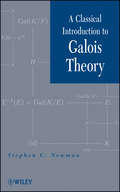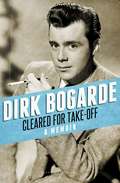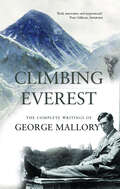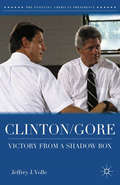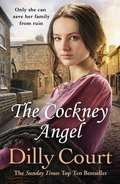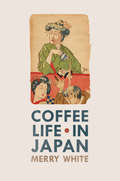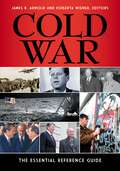- Table View
- List View
The Classical Hollywood Reader
by Steve NealeThe Classical Hollywood Reader brings together essential readings to provide a history of Hollywood from the 1910s to the mid 1960s. Following on from a Prologue that discusses the aesthetic characteristics of Classical Hollywood films, Part 1 covers the period between the 1910s and the mid-to-late 1920s. It deals with the advent of feature-length films in the US and the growing national and international dominance of the companies responsible for their production, distribution and exhibition. In doing so, it also deals with film making practices, aspects of style, the changing roles played by women in an increasingly business-oriented environment, and the different audiences in the US for which Hollywood sought to cater. Part 2 covers the period between the coming of sound in the mid 1920s and the beginnings of the demise of the `studio system` in late 1940s. In doing so it deals with the impact of sound on films and film production in the US and Europe, the subsequent impact of the Depression and World War II on the industry and its audiences, the growth of unions, and the roles played by production managers and film stars at the height of the studio era. Part 3 deals with aspects of style, censorship, technology, and film production. It includes articles on the Production Code, music and sound, cinematography, and the often neglected topic of animation. Part 4 covers the period between 1946 and 1966. It deals with the demise of the studio system and the advent of independent production. In an era of demographic and social change, it looks at the growth of drive-in theatres, the impact of television, the advent of new technologies, the increasing importance of international markets, the Hollywood blacklist, the rise in art house imports and in overseas production, and the eventual demise of the Production Code. Designed especially for courses on Hollywood Cinema, the Reader includes a number of newly researched and written chapters and a series of introductions to each of its parts. It concludes with an epilogue, a list of resources for further research, and an extensive bibliography.
A Classical Introduction to Galois Theory
by Stephen C. NewmanExplore the foundations and modern applications of Galois theory Galois theory is widely regarded as one of the most elegant areas of mathematics. A Classical Introduction to Galois Theory develops the topic from a historical perspective, with an emphasis on the solvability of polynomials by radicals. The book provides a gradual transition from the computational methods typical of early literature on the subject to the more abstract approach that characterizes most contemporary expositions. The author provides an easily-accessible presentation of fundamental notions such as roots of unity, minimal polynomials, primitive elements, radical extensions, fixed fields, groups of automorphisms, and solvable series. As a result, their role in modern treatments of Galois theory is clearly illuminated for readers. Classical theorems by Abel, Galois, Gauss, Kronecker, Lagrange, and Ruffini are presented, and the power of Galois theory as both a theoretical and computational tool is illustrated through: A study of the solvability of polynomials of prime degree Development of the theory of periods of roots of unity Derivation of the classical formulas for solving general quadratic, cubic, and quartic polynomials by radicals Throughout the book, key theorems are proved in two ways, once using a classical approach and then again utilizing modern methods. Numerous worked examples showcase the discussed techniques, and background material on groups and fields is provided, supplying readers with a self-contained discussion of the topic. A Classical Introduction to Galois Theory is an excellent resource for courses on abstract algebra at the upper-undergraduate level. The book is also appealing to anyone interested in understanding the origins of Galois theory, why it was created, and how it has evolved into the discipline it is today.
A Classical Introduction to Galois Theory
by Stephen C. NewmanExplore the foundations and modern applications of Galois theory Galois theory is widely regarded as one of the most elegant areas of mathematics. A Classical Introduction to Galois Theory develops the topic from a historical perspective, with an emphasis on the solvability of polynomials by radicals. The book provides a gradual transition from the computational methods typical of early literature on the subject to the more abstract approach that characterizes most contemporary expositions. The author provides an easily-accessible presentation of fundamental notions such as roots of unity, minimal polynomials, primitive elements, radical extensions, fixed fields, groups of automorphisms, and solvable series. As a result, their role in modern treatments of Galois theory is clearly illuminated for readers. Classical theorems by Abel, Galois, Gauss, Kronecker, Lagrange, and Ruffini are presented, and the power of Galois theory as both a theoretical and computational tool is illustrated through: A study of the solvability of polynomials of prime degree Development of the theory of periods of roots of unity Derivation of the classical formulas for solving general quadratic, cubic, and quartic polynomials by radicals Throughout the book, key theorems are proved in two ways, once using a classical approach and then again utilizing modern methods. Numerous worked examples showcase the discussed techniques, and background material on groups and fields is provided, supplying readers with a self-contained discussion of the topic. A Classical Introduction to Galois Theory is an excellent resource for courses on abstract algebra at the upper-undergraduate level. The book is also appealing to anyone interested in understanding the origins of Galois theory, why it was created, and how it has evolved into the discipline it is today.
A Classical Primer: Ancient Knowledge for Modern Minds
by Dan CromptonDidn't take Classics at school? Or maybe you've forgotten most of what you once knew? To save you looking it up, Classics is the study of the culture of the ancient Greeks and Romans, and takes in all aspects of their life and learning - from the languages to literature, philosophy, art, and much more besides. A Classical Primer is an accessible and enjoyable look back at classical civilization; how they lived, and how many aspects of our own daily lives have been directly influenced by theirs, from roads and concrete, to central heating, the twelve-month calendar, cranes and even the modern-day favourite, pizza! This handy, informative and enjoyable book is the perfect primer for people of all ages, and shows that even a basic knowledge of Classics is not only essential, bus also incredibly fascinating.
Cleansing Honor with Blood: Masculinity, Violence, and Power in the Backlands of Northeast Brazil, 1845–1889
by Martha SantosThis book offers a critical reinterpretation of male violence, patriarchy, and machismo in rural Latin America. It focuses on the lives of lower-class men and women, known as sertanejo/as, in the hinterlands of the northeastern Brazilian province of Ceará between 1845 and 1889. Challenging the widely accepted depiction of sertanejos as conditioned to violence by nature, culture, and climate, Santos argues that their concern with maintaining an honorable manly reputation and the use of violence were historically contingent strategies employed to resolve conflicts over scant resources and to establish power over women and other men. She also traces a shift in the functioning of patriarchy that coincided with changes in the material fortunes of sertanejo families. As economic dislocation, environmental calamity, and family separation led to greater female autonomy and an erosion of patriarchal authority in the home, public—and often violent—enforcement of male power maintained patriarchal order in these communities.
Cleared For Take-Off: A Memoir
by Dirk BogardeFirst published in 1997, Cleared for Take-Off is the seventh and final volume of Dirk Bogarde's best-selling memoirsDuring his many reconnaissance missions in Europe and the Far East, the young Bogarde experienced the terror of enemy attack and the horror of its aftermath, together with the intense camaraderie and bitter humour of the battlefield. He also felt, like countless others, a feeling of utter hopelessness at the war's end, when these youthful, but hardened comrades-in-arms were dispersed to find their feet in a traumatised world. Less than a year after demob, Bogarde found himself starring in his third feature film with car, chauffeur and five-storey house in Chester Row. He had somehow 'arrived' in the movies.
Climate Clever: How Governments Can Tackle Climate Change (and Still Win Elections)
by Hugh Compston Ian BaileyWhy, despite two decades of climate policy, have affluent democracies made so little progress in cutting greenhouse gas emissions? We know that there are ways of doing this that are both practical and affordable. It is politics that is the problem. Stringent climate policies may lead companies to redirect investment elsewhere, or lead voters to retaliate at the ballot box. There are many political obstacles to stronger action. What can be done? Based on an analysis of the logic of policy making, plus observation of recent developments in climate politics, this book identifies a broad range of political strategies that are available to governments that wish to take more effective action against climate change while avoiding serious political damage. Separate chapters deal with strategies relating to unilateral action, persuasion, political exchange, and changing the terms of political exchange. This is the first book-length study of political strategy and climate change and will be of interest not only to policymakers but also to experts and activists looking to formulate politically realistic policy proposals, and scholars and students of politics and environmental studies.
Climate Clever: How Governments Can Tackle Climate Change (and Still Win Elections)
by Hugh Compston Ian BaileyWhy, despite two decades of climate policy, have affluent democracies made so little progress in cutting greenhouse gas emissions? We know that there are ways of doing this that are both practical and affordable. It is politics that is the problem. Stringent climate policies may lead companies to redirect investment elsewhere, or lead voters to retaliate at the ballot box. There are many political obstacles to stronger action. What can be done? Based on an analysis of the logic of policy making, plus observation of recent developments in climate politics, this book identifies a broad range of political strategies that are available to governments that wish to take more effective action against climate change while avoiding serious political damage. Separate chapters deal with strategies relating to unilateral action, persuasion, political exchange, and changing the terms of political exchange. This is the first book-length study of political strategy and climate change and will be of interest not only to policymakers but also to experts and activists looking to formulate politically realistic policy proposals, and scholars and students of politics and environmental studies.
Climbing Everest: The Complete Writings of George Leigh Mallory
by George Leigh Mallory'Compelling pieces.' Stephen Venables, Mail on Sunday 'Invaluable... [a] surprise it has taken so long to see the light of day.' National Geographic 'Expressive and emotionally literate.' Scottish Mountaineer In Climbing Everest, George Mallory (18 June 1886 - 8/9 June 1924), possibly the first man to summit Everest, takes us with him on his climbs in Britain and the Alps, culminating in his three expeditions to Mount Everest - the last of which cost him his life (a few days after the final piece in this book). Mallory was one of the first climbers to explore the emotional meaning of climbing, discarding the Edwardian stiff upper lip in the face of adventure. All his writings on climbing - here collected for the first time - started out as letters to his wife Ruth. He turned them into finely-crafted pieces read by climbers as well as arm-chair climbers.
Clinton/Gore: Victory from a Shadow Box (The Evolving American Presidency)
by Jeffrey J. VolleWhat if Clinton/Gore lost in 1992? Or won in 1992 and lost in 1996? This book is a look back at the importance of all the right moves made by Bill Clinton from the New Hampshire primary to the selection of Al Gore as his running mate to his handling of the Republican takeover of the House of Representatives in 1994-95.
Cloak of Enemies: Churchill's SOE, Enemies at Home and the Cockleshell Heroes
by Tom KeeneSOE was born from Churchill’s vision to set ‘Europe ablaze’. However, Tom Keene’s book reveals for the first time how close it came to never existing at all. Many saw SOE as a threat to the existence of MI5 and other intelligence agencies, and some in the armed forces refused to work with the new agency, fearing its broad remit and lack of experienced operatives. SOE, in turn, became ever more secretive, hiding details of their operations from anyone outside the agency. This backstabbing climate of rivalry, confusion and secrecy, not only nearly destroyed SOE, but also had tragic repercussions for the daring Commandos who took part in the legendary ‘Cockleshell Raid’. Cloak of Enemies exposes the secret war within Whitehall and its far-reaching consequences.
The Club: A Rouge Regency Romance
by Sharon PageIt is London's most secretive gentlemen's club - a place where no well-bred lady would dare to be seen. But Lady Jane Beaumont has no choice. Her friend Delphiniahas vanished, and Jane must enter into a dangerous charade to find her. Now, within the gilded walls of this erotic lair, Jane awaits the lover she has procured for the evening. But the man who enters her bedchamber is no stranger. He is Delphinia's brother and London's most notorious rake - a man on a rescue mission of his own. Christian is intrigued by the innocent beauty who clearly does not belong in the notorious brothel. And as the two seek out the damning secrets of the club...as Christian initiates Jane into the ways of true sensual pleasure, she knows she has entered the most dangerous place of all - where the price of temptation could be her heart...Rouge Romance - your first stop for romance books
Coal in our Veins: A Personal Journey
by Erin Ann ThomasIn Coal in Our Veins, Erin Thomas employs historical research, autobiography, and journalism to intertwine the history of coal, her ancestors' lives mining coal, and the societal and environmental impacts of the United States' dependency on coal as an energy source. In the first part of her book, she visits Wales, native ground of British coal mining and of her emigrant ancestors. The Thomases' move to the coal region of Utah—where they witnessed the Winter Quarters and Castle Gate mine explosions, two of the worst mining disasters in American history—and the history of coal development in Utah form the second part. Then Thomas investigates coal mining and communities in West Virginia, near her East Coast home, looking at the Sago Mine collapse and more widespread impacts of mining, including population displacement, mountain top removal, coal dust dispersal, and stream pollution, flooding, and decimation. The book's final part moves from Washington D.C.—and an examination of coal, CO2, and national energy policy—back to Utah, for a tour of a coal mine, and a consideration of the Crandall Canyon mine cave-in, back to Wales and the closing of the oldest operating deep mine in the world and then to a look at energy alternatives, especially wind power, in West Virginia and Pennsylvania.
The Cockney Angel
by Dilly CourtEighteen-year-old Irene Angel lives with her parents in a tiny room above the shop where her crippled mother ekes out a living selling pickles and sauces, whilst her charming but feckless father Billy gambles away what little money they do manage to earn. And it is all Irene can do to keep the family together. Billy's addiction soon leads him into trouble. Despite having been brought up by her father to fear and distrust the police, Irene finds herself forced to collaborate with them to save her father from ruin. But Billy's errant ways finally catch up with him and he is imprisoned in Newgate jail. With her mother away from home, a desperate Irene has little choice but to seek help from Inspector Edward Kent - her sworn enemy. For only she can clear her father's name and unite the family once more ...
Coffee Life In Japan (California Studies In Food And Culture Ser. (PDF) #36)
by Merry WhiteThis fascinating book-part ethnography, part memoir-traces Japan's vibrant café society over one hundred and thirty years. Merry White traces Japan's coffee craze from the turn of the twentieth century, when Japan helped to launch the Brazilian coffee industry, to the present day, as uniquely Japanese ways with coffee surface in Europe and America. White's book takes up themes as diverse as gender, privacy, perfectionism, and urbanism. She shows how coffee and coffee spaces have been central to the formation of Japanese notions about the uses of public space, social change, modernity, and pleasure. White describes how the café in Japan, from its start in 1888, has been a place to encounter new ideas and experiments in thought, behavior, sexuality , dress, and taste. It is where a person can be socially, artistically, or philosophically engaged or politically vocal
Coinage and Coin Use in Medieval Italy
by Alessia RovelliThe volume gathers together seventeen articles dedicated to the monetary history of medieval Italy, most of them newly translated into English. The articles in the first section of the volume trace the development of monetisation in Italy from the Lombard period until the rise of the communes, taking Rome, Lazio, Tuscany, and several cities and regions in north-central Italy as case studies. The articles in the second section analyse different aspects of monetary production and circulation in Byzantine Italy, while the third gathers together studies on various aspects of Carolingian coinage: the transition from the Lombard system and the problem of furnishing an adequate supply of silver; mints and royal administration; and the activity and inactivity of mints operating at the edges of the Regnum Italiae. All of the articles share the author’s characteristic concern with setting the evidence from written sources against the wealth of new data emerging from recent archaeological research.
Coinage and Coin Use in Medieval Italy
by Alessia RovelliThe volume gathers together seventeen articles dedicated to the monetary history of medieval Italy, most of them newly translated into English. The articles in the first section of the volume trace the development of monetisation in Italy from the Lombard period until the rise of the communes, taking Rome, Lazio, Tuscany, and several cities and regions in north-central Italy as case studies. The articles in the second section analyse different aspects of monetary production and circulation in Byzantine Italy, while the third gathers together studies on various aspects of Carolingian coinage: the transition from the Lombard system and the problem of furnishing an adequate supply of silver; mints and royal administration; and the activity and inactivity of mints operating at the edges of the Regnum Italiae. All of the articles share the author’s characteristic concern with setting the evidence from written sources against the wealth of new data emerging from recent archaeological research.
Cold Case Files Missing and Unsolved: The Cold Case Files
by Barry CumminsThe Cold Case Files will leave you shocked that so many of Ireland’s evil killers have not been caught. But by outlining the on-going work of Ireland’s cold-case detectives, this book will also give you hope that these killers will never be allowed to rest easy, and that one day justice will come knocking on their door.Unsolved: the 1981 fatal shooting of Lorcan O’Byrne, who was targeted by robbers on the night he was celebrating his engagement. Unsolved: the murder of Grace Livingstone, who was found shot dead in her Malahide home in 1992.Unsolved: the abduction and suspected murder of Brooke Pickard, who was last seen in Co. Kerry in 1991.Cummins also charts the re-investigation into the first case to be solved by the Cold Case Unit: the killing and secret burial of Brian McGrath in Westmeath in 1987.
The Cold War: History In An Hour (History In An Hour Ser.)
by Rupert ColleyLove history? Know your stuff with History in an Hour.
Cold War: The Essential Reference Guide (Library Of Modern American History Ser.)
by James R. Arnold Roberta Wiener Dr Valerie Adams Dr Dewi I. Ball Lacie A. Ballinger Dr Jakub Basista Robert G. Berschinski Frank Beyersdorf Anna Boros-McGee Christopher John Bright Colonel George M. Brooke III Barry Carr Phillip Deery Dr Bruce J. DeHart Dr Jérôme Dorvidal Dr Timothy C. Dowling Jaroslav Dvorak Dr Lee W. Eysturlid Dr Richard M. Filipink Jr. Dr Philipp Gassert Beatrice De Graaf Magarditsch Hatschikjan Kurt Heinrich James J. Hentz John C. Horn Dr Donna R. Jackson A. Ross Johnson Brian Madison Jones Dr Melissa Jordine Robert S. Kiely Dr Arne Kislenko Jonathan H. L’Hommedieu Dr Jeffrey A. Larsen Daniel Lewis Arturo Lopez-Levy Dr Lorenz M. Lüthi Dr Jerome V. Martin Dr James I. Matray A. Gregory Moore Caryn E. Neumann Dr Christian Nuenlist Dr Vernon L. Pedersen Allene Phy-Olsen Dr Paul G. Pierpaoli Jr. Dr Michael Richards Dr Priscilla Roberts Bevan Sewell Colonel Charles G. Simpson Dr Larry Simpson Sarah B. Snyder Dr Daniel E. Spector Dr David Tal Dr Aviezer Tucker Dr Spencer C. Tucker Josh Ushay Joseph Robert White Dr James H. Willbanks Law Yuk-FunThe impact of the Cold War is still being felt around the world today. This insightful single-volume reference captures the events and personalities of the era, while also inspiring critical thinking about this still-controversial period.Cold War: The Essential Reference Guide is intended to introduce students to the tensions between the Soviet Union and the United States that dominated international affairs in the second half of the 20th century. A comprehensive overview essay, plus separate essays on the causes and consequences of the conflict, will provide readers with the necessary context to understand the many facets of this complex era.The guide's expert contributors cover all of the influential people and pivotal events of the period, encompassing the United States, the Soviet Union, Europe, Southeast Asia, China, the Middle East, Latin America, and Africa from political, military, and cultural perspectives. Reference entries offer valuable insight into the leaders and conflicts that defined the Cold War, while other essays promote critical thinking about controversial and significant Cold War topics, including whether Ronald Reagan was responsible for ending the Cold War, the impact of Sputnik on the Cold War, and the significance of the Prague Spring.
Cold War: The Essential Reference Guide
by James R. Arnold Roberta WienerThe impact of the Cold War is still being felt around the world today. This insightful single-volume reference captures the events and personalities of the era, while also inspiring critical thinking about this still-controversial period.Cold War: The Essential Reference Guide is intended to introduce students to the tensions between the Soviet Union and the United States that dominated international affairs in the second half of the 20th century. A comprehensive overview essay, plus separate essays on the causes and consequences of the conflict, will provide readers with the necessary context to understand the many facets of this complex era.The guide's expert contributors cover all of the influential people and pivotal events of the period, encompassing the United States, the Soviet Union, Europe, Southeast Asia, China, the Middle East, Latin America, and Africa from political, military, and cultural perspectives. Reference entries offer valuable insight into the leaders and conflicts that defined the Cold War, while other essays promote critical thinking about controversial and significant Cold War topics, including whether Ronald Reagan was responsible for ending the Cold War, the impact of Sputnik on the Cold War, and the significance of the Prague Spring.
The Cold War and After: History, Theory, and the Logic of International Politics
by Marc TrachtenbergWhat makes for war or for a stable international system? Are there general principles that should govern foreign policy? In The Cold War and After, Marc Trachtenberg, a leading historian of international relations, explores how historical work can throw light on these questions. The essays in this book deal with specific problems--with such matters as nuclear strategy and U.S.-European relations. But Trachtenberg's main goal is to show how in practice a certain type of scholarly work can be done. He demonstrates how, in studying international politics, the conceptual and empirical sides of the analysis can be made to connect with each other, and �how historical, theoretical, and even policy issues can be tied together in an intellectually respectable way. These essays address a wide variety of topics, from theoretical and policy issues, such as the question of preventive war and the problem of international order, to more historical subjects--for example, American policy on Eastern Europe in 1945 and Franco-American relations during the Nixon-Pompidou period. But in each case the aim is to show how a theoretical perspective can be brought to bear on the analysis of historical issues, and how historical analysis can shed light on basic conceptual problems.
The Cold War and After: History, Theory, and the Logic of International Politics
by Marc TrachtenbergWhat makes for war or for a stable international system? Are there general principles that should govern foreign policy? In The Cold War and After, Marc Trachtenberg, a leading historian of international relations, explores how historical work can throw light on these questions. The essays in this book deal with specific problems--with such matters as nuclear strategy and U.S.-European relations. But Trachtenberg's main goal is to show how in practice a certain type of scholarly work can be done. He demonstrates how, in studying international politics, the conceptual and empirical sides of the analysis can be made to connect with each other, and �how historical, theoretical, and even policy issues can be tied together in an intellectually respectable way. These essays address a wide variety of topics, from theoretical and policy issues, such as the question of preventive war and the problem of international order, to more historical subjects--for example, American policy on Eastern Europe in 1945 and Franco-American relations during the Nixon-Pompidou period. But in each case the aim is to show how a theoretical perspective can be brought to bear on the analysis of historical issues, and how historical analysis can shed light on basic conceptual problems.
Cold War Cultures: Perspectives on Eastern and Western European Societies
by Annette Vowinckel, Marcus M. Payk Thomas LindenbergerThe Cold War was not only about the imperial ambitions of the super powers, their military strategies, and antagonistic ideologies. It was also about conflicting worldviews and their correlates in the daily life of the societies involved. The term “Cold War Culture” is often used in a broad sense to describe media influences, social practices, and symbolic representations as they shape, and are shaped by, international relations. Yet, it remains in question whether — or to what extent — the Cold War Culture model can be applied to European societies, both in the East and the West. While every European country had to adapt to the constraints imposed by the Cold War, individual development was affected by specific conditions as detailed in these chapters. This volume offers an important contribution to the international debate on this issue of the Cold War impact on everyday life by providing a better understanding of its history and legacy in Eastern and Western Europe.
Cold War in the Congo: The Confrontation of Cuban Military Forces, 1960-1967
by Frank VillafanaIt is widely acknowledged that Congo became an East- West battlefield during the first half of the decade of the 1960s, yet the participation of Cuban exiles in the struggles is rarely noted. In this absorbing volume Villafana details the contribution made by Cuban exiles to the preservation of democracy in Congo.When Congo was given its independence by Belgium in 1960, most of its people believed their new government had been installed by the West and opposed it. Anti-colonial, anti-government Congolese patriots started fighting. Some were pro-communist, some anti-communist, and most didn't know the difference. Many countries were involved on both sides of this conflict: Cuba, the Soviet Union, The People's Republic of China, the United States (represented by military advisors, the CIA and Cuban exiles), Belgium, France, the United Kingdom, and several African nations. The Cold War made the involvement of some of these countries predictable, but not the Cuban involvement.Villafana explores reasons for Castro's involvement in Congo. He considers whether Castro was operating with a master plan, of which Africa was a key. He discusses why Castro chose Che Guevara to head the ill-fated military expedition. He contemplates why the United States allowed Castro to freely export his revolution, and why it used Cuban exiles to prevent the mineral riches of Congo from falling into the hands of international communism. Villafana shows that CIA-sponsored Miami Cuban exiles were instrumental in thwarting Castro's plans for Congo, which were believed to have included a confederacy with Tanzania and Congo (Brazzaville), to gain control of Central Africa and its vast resources.

